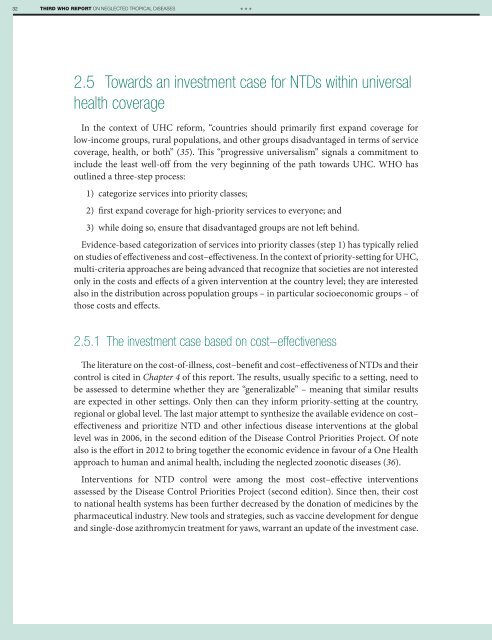1A9bnbK
1A9bnbK
1A9bnbK
Create successful ePaper yourself
Turn your PDF publications into a flip-book with our unique Google optimized e-Paper software.
32 THIRD WHO REPORT ON NEGLECTED TROPICAL DISEASES<br />
***<br />
2.5 Towards an investment case for NTDs within universal<br />
health coverage<br />
In the context of UHC reform, “countries should primarily first expand coverage for<br />
low-income groups, rural populations, and other groups disadvantaged in terms of service<br />
coverage, health, or both” (35). This “progressive universalism” signals a commitment to<br />
include the least well-off from the very beginning of the path towards UHC. WHO has<br />
outlined a three-step process:<br />
1) categorize services into priority classes;<br />
2) first expand coverage for high-priority services to everyone; and<br />
3) while doing so, ensure that disadvantaged groups are not left behind.<br />
Evidence-based categorization of services into priority classes (step 1) has typically relied<br />
on studies of effectiveness and cost–effectiveness. In the context of priority-setting for UHC,<br />
multi-criteria approaches are being advanced that recognize that societies are not interested<br />
only in the costs and effects of a given intervention at the country level; they are interested<br />
also in the distribution across population groups – in particular socioeconomic groups – of<br />
those costs and effects.<br />
2.5.1 The investment case based on cost−effectiveness<br />
The literature on the cost-of-illness, cost–benefit and cost–effectiveness of NTDs and their<br />
control is cited in Chapter 4 of this report. The results, usually specific to a setting, need to<br />
be assessed to determine whether they are “generalizable” – meaning that similar results<br />
are expected in other settings. Only then can they inform priority-setting at the country,<br />
regional or global level. The last major attempt to synthesize the available evidence on cost–<br />
effectiveness and prioritize NTD and other infectious disease interventions at the global<br />
level was in 2006, in the second edition of the Disease Control Priorities Project. Of note<br />
also is the effort in 2012 to bring together the economic evidence in favour of a One Health<br />
approach to human and animal health, including the neglected zoonotic diseases (36).<br />
Interventions for NTD control were among the most cost–effective interventions<br />
assessed by the Disease Control Priorities Project (second edition). Since then, their cost<br />
to national health systems has been further decreased by the donation of medicines by the<br />
pharmaceutical industry. New tools and strategies, such as vaccine development for dengue<br />
and single-dose azithromycin treatment for yaws, warrant an update of the investment case.


